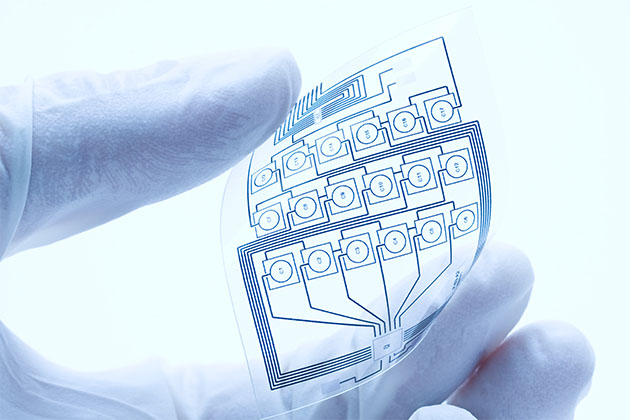इंजीनियरों ने एक पतली लचीली संकर सामग्री से बने अर्धचालक का आविष्कार किया है जिसका उपयोग निकट भविष्य में इलेक्ट्रॉनिक उपकरणों पर प्रदर्शित करने के लिए किया जा सकता है।
बड़े निगमों के इंजीनियर इलेक्ट्रॉनिक के लिए एक फोल्डेबल और लचीली डिस्प्ले स्क्रीन डिजाइन करने पर ध्यान दे रहे हैं उपकरणों like computers and mobile phones. The goal is a display screen which would feel like a paper i.e. be bendable but also function electronically. Samsung, one of the largest mobile phone manufacturers in the world will in all probability be launching a flexible mobile phone very soon. They have developed a flexible जैविक light emitting diode (OLED) panel which has an unbreakable surface. It is lightweight but tough and robust and can withstand high temperatures. Its most remarkable feature would be that this display will not break or be damaged if the device falls – the biggest challenge faced today by mobile phone display designers. A regular LCD screen continues to display even when bent but the liquid inside it becomes misaligned and hence a distorted image is displayed. The new flexible OLED screen could be bent or curved without distorting the display, however, it still won’t be completely foldable. The flexibility can be further increased by using more flexible nanowires in the future. A quantum dot light emitting diode display is more flexible because of the use of nano-crystals to produce high-quality sharp light. The displays still have to be encapsulated into glass or other material for protection.
लचीली स्क्रीन बनाने के लिए एक नई सामग्री
में प्रकाशित एक हालिया अध्ययन में उन्नत सामग्री engineers from The Australian National University (ANU) have for the first time developed a semiconductor made from जैविक and inorganic material which efficiently converts electricity into light. This semiconductor is ultra-thin and very flexible making it unique. The जैविक part of the device, an important part of the semiconductor has a thickness of only one atom. The inorganic part is also small, about two atoms thick. The material was constructed by a process called ‘chemical vapor deposition’, similar to building a 3-dimensional structure from a 2D description. The semiconductor cannot be seen with naked eye, it rests between gold electrodes on a chip of size 1cm x 1cm having a functional transistor. One such chip can hold thousands of transistor circuits. The electrode serves as electricity input and output point. Once constructed opto-electronic and electrical properties of the material were characterized. This hybrid structure of जैविक and inorganic components converts electricity into light which then provides display on mobile phones, televisions and other devices. The light emission is seen to be sharper and better for higher-resolution displays.
ऐसी सामग्री का उपयोग निकट भविष्य में उपकरणों को मोड़ने योग्य बनाने के लिए किया जा सकता है - उदाहरण के लिए मोबाइल फोन। मोबाइल फोन में स्क्रीन या डिस्प्ले की क्षति बहुत आम है और यह सामग्री बचाव में आ सकती है। बड़ी स्क्रीन वाले स्मार्ट फोन की लोकप्रियता और मांग बढ़ने के साथ, समय की आवश्यकता है कि स्थायित्व हो ताकि डिस्प्ले खरोंच या टूटने या गिरने आदि का खतरा न हो। हाइब्रिड संरचना पारंपरिक अर्धचालकों की तुलना में दक्षता के मामले में फायदेमंद है जो कि हैं पूरी तरह से सिलिकॉन से बना है। इस सामग्री का उपयोग मोबाइल फोन, टेलीविजन, डिजिटल कंसोल आदि के लिए स्क्रीन बनाने और शायद एक दिन कंप्यूटर बनाने और या मोबाइल फोन को सुपर कंप्यूटर की तरह मजबूत बनाने के लिए किया जा सकता है। शोधकर्ता पहले से ही इस सेमीकंडक्टर को बड़े पैमाने पर बनाने पर काम कर रहे हैं ताकि इसका व्यावसायीकरण किया जा सके।
इलेक्ट्रॉनिक कचरे से निपटना
It is estimated that 2018 will be produce a total of almost 50 million tons of electronic waste (e-waste) and very limited quantity would be recycled. E-waste constitutes electronic devices and equipment which have reached the end of their life and need to be discarded including old computers, office or entertainment electronic equipment, mobile phones, television etc. Massive amount of e-waste is a huge threat to the environment and is bound to cause irreversible damage to our natural resources and surroundings. This discovery is a starting point for designing electronic devices exhibiting high performance but which are made from जैविक ‘bio’ materials. If mobile phones were made of a flexible material they would be easier to recycle. This will cut down on e-waste generated annually across the globe.
फोल्डेबल और लचीले इलेक्ट्रॉनिक उपकरणों का भविष्य बहुत ही शानदार होने वाला है। इंजीनियर पहले से ही रोल करने योग्य डिस्प्ले के बारे में सोच रहे हैं जहां उपकरणों को स्क्रॉल की तरह रोल किया जा सकता है। डिस्प्ले स्क्रीन का सबसे उन्नत प्रकार होगा जो कागज की तरह मोड़, वक्र या यहां तक कि क्रश कर सकता है लेकिन साफ-सुथरी छवियों को प्रदर्शित करना जारी रख सकता है। एक अन्य क्षेत्र 'ऑक्टेटिक' सामग्री का उपयोग है जो खींचे जाने पर मोटा हो जाता है और जो उच्च ऊर्जा प्रभावों को अवशोषित कर सकता है और किसी भी विकृति को ठीक करने के लिए आत्म-संरेखण कर सकता है। ऐसे उपकरण हल्के लेकिन लचीले होंगे।
***
{आप उद्धृत स्रोतों की सूची में नीचे दिए गए डीओआई लिंक पर क्लिक करके मूल शोध पत्र पढ़ सकते हैं}
स्रोत (रों)
शर्मा ए एट अल। 2018 एटॉमिकली थिन ऑर्गेनिक-इनऑर्गेनिक टाइप-I हेटरोस्ट्रक्चर में कुशल और परत-आश्रित एक्साइटन पंपिंग। उन्नत सामग्री। 30 (40)।
https://doi.org/10.1002/adma.201803986
***






































